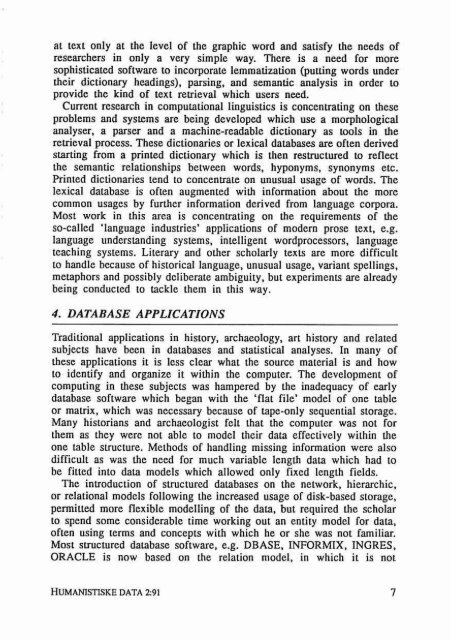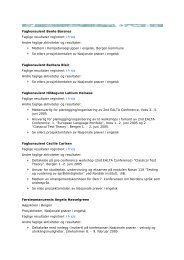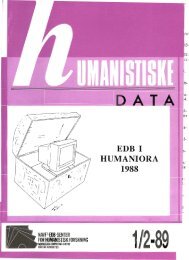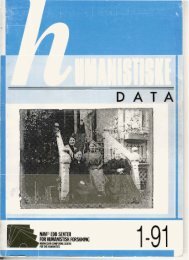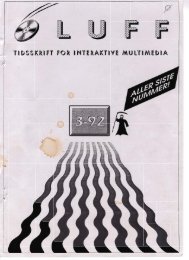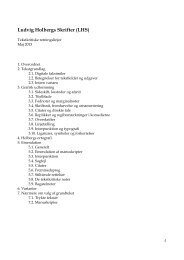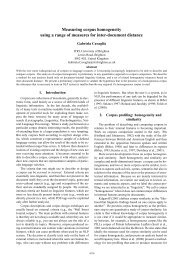1991:2 - Universitetet i Bergen
1991:2 - Universitetet i Bergen
1991:2 - Universitetet i Bergen
You also want an ePaper? Increase the reach of your titles
YUMPU automatically turns print PDFs into web optimized ePapers that Google loves.
at text only at the Etvel of the graphic word and satisfy the needs of<br />
researchers in only a very simple way. There is a need for more<br />
sophistieated software to incorporate Iemmatization @utting words under<br />
their dfctionary hcadings), pusing, and sernantic analysis in order to<br />
provide the kind of text retrieval which users need.<br />
Currenr research in compuhtional linguistics is concentrating on these<br />
problerns and systems are being developed which use a morphoIogica1<br />
analyser, a parser and a machine-readable dictionary as mls in the<br />
retrieval process. Thesc dictionaries or Icxical databases are often derived<br />
starting from a prioted dictionary which is then resrnictured to reflect<br />
the sernantic relationships bctween words, hyponyms, synonyms etc.<br />
Printed diclionarics tend ta concenuate on unusual usage of words. The<br />
Iexical database is often augrnented wilh information about the more<br />
comrnon usagcs by further information derived from language corpora.<br />
Most work in this area is concenuating on the requisemenls of the<br />
so-called "anguage industries' applications of modcrn prose text, e-g.<br />
language understanding systems, intelligent wordprocessors, language<br />
teaching systems. Literaq and oiher schaIarly texts arc more difficult<br />
to handle because of historical language, unusual usage, variant spellings,<br />
meraphors and possibly dcIiberate ambiguity, but experiments are already<br />
being conducted to tackle them in this way.<br />
4. DATABASE A PPLICATIONS<br />
TradiSional applications in histary, archacology, art history and related<br />
subjecls have been in databases and statistical analyser,. In many of<br />
these applications it is less clear what the source material is and how<br />
to identify and organize it within the computer. The development of<br />
compuling in hese subjects was harnpered by the inadequacy of early<br />
database software which began with the 'flat file' model of one table<br />
or rnatnx, which was necessary because of tape-only sequential sterage.<br />
Many historians and archacologisl fell that the computer was not for<br />
them as lhey were nor able to model their data elfectively within the<br />
one tablc stnicture. Methods of handling missing information werc also<br />
difficult as was Lhe ned for much variable Iengfh data which had to<br />
be fitted into data models which allowed only fixed lengih fields.<br />
The intraduction of stnictured dalabases on the nelwork, hierarchic,<br />
or relatienal modcls folIowing the increased usage OF disk-based sierage,<br />
permitted more flexibIe modelling of the data, but requircd the scholar<br />
lo spend some considetable time working nut an entity made1 for data,<br />
often using rems and concepts wiih which he or she wac not fmiIiar.<br />
Most sttuctured dalabase software. e-g. DBASE, INFORMIX. TNGRES,<br />
ORACLE is naw based on the relation model, in which it is not<br />
HUMANISTISKE DATA M 1 7


